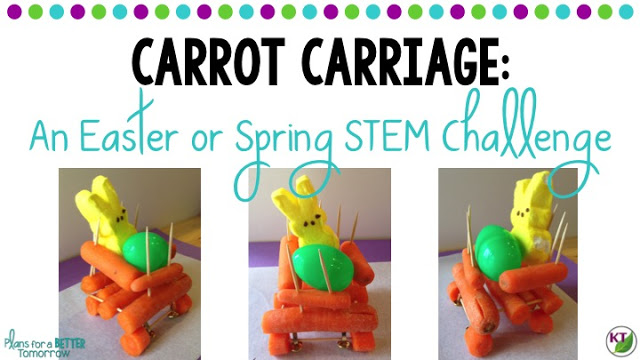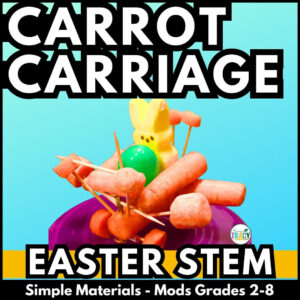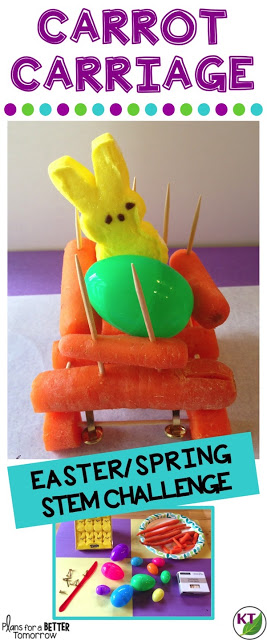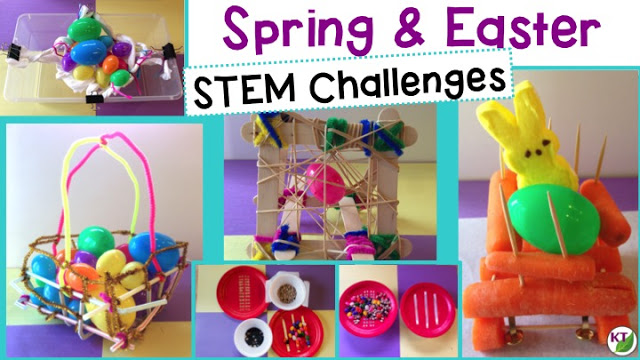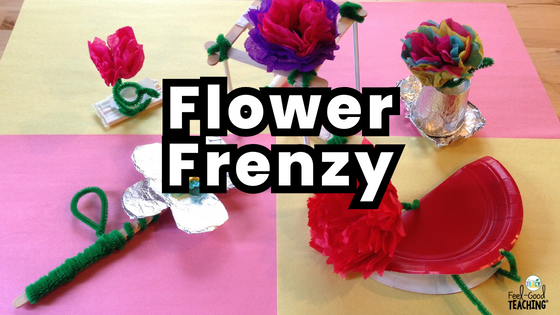Carrot Carriage is a fan favorite STEM Challenge! Your students will use an unlikely set of materials to create a sweet, new ride for the Easter Bunny! (Read on for ways around the Easter connection!)
Premise
Working against a criteria & constraints list, students design a vehicle made primarily of carrots for the Easter Bunny. If you don’t celebrate Easter, not to worry! Carrot Carriage can be for Cinderella (imagine Fairy Godmother ran out of pumpkins), or for anyone else who might need a ride this spring! You can do this as an individual, partner, or group challenge (partners or groups are recommended).
Materials
Note: The links below are Amazon Affiliate links. Find out more on the disclosure page.
- Large carrots (4 – 6)
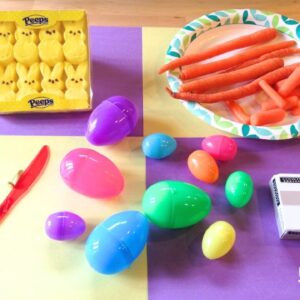
- Small carrots (4 – 8)
- Peeps bunnies (1)
- Plastic eggs (1)
- Butter knife or plastic knife (1)
- Straws (1-2)
- Toothpicks (10 – 20)
- Brass fasteners (4 – 8)
- Scissors
- Ramp (1)
- Simple ramp will be used to test designs (e.g. textbook propped at an angle)
- Ruler (1)
- Used to measure travel distance of carriages
- Design analysis handouts (included in resource)
Optional:
- Cutting boards
- Rubber bands
- Balloons
- String/yarn
- Foil
Video Walk-through
If you’re familiar with me, you know I’ve been switching over to using video to explain the bulk of my challenges. It seems to be the best/fastest way to explain the important details: materials, set-up, tips, modifications, extensions, demonstrations, and more! Who has time to read all that?! However, if you prefer to read, you’ll find the video transcribed at the end of this post.
Check out the video below to see Carrot Carriage in action:
Are There Other Easter & Spring STEM Challenges Like This?
Of course! I can’t help myself! I have created 5 challenges for Easter & spring (with plans for a few more coming soon)! You can find the overview of each on this blog post.
PIN ME
Video Transcription
Hi, welcome back to the Easter and spring STEM challenges. Today we are going to be
talking about carrot carriage. And this is a challenge where students are going
to be making a vehicle primarily of carrots for the Easter bunny. Now, if
you’re not doing Easter in your classroom, you can still do this challenge. The
carriage instead could be for Cinderella if the fairy god mother ran out of
pumpkins or anyone else who might need a ride. Maybe this guy.
talking about carrot carriage. And this is a challenge where students are going
to be making a vehicle primarily of carrots for the Easter bunny. Now, if
you’re not doing Easter in your classroom, you can still do this challenge. The
carriage instead could be for Cinderella if the fairy god mother ran out of
pumpkins or anyone else who might need a ride. Maybe this guy.
Let’s take a moment to check out the materials and the STEM challenge cycle.
This is the STEM challenge cycle you should follow for every challenge. I’ve defined
each step in another video. I’ve added a pop-in card to that video here as well
as a link in the description. A few notes about materials. I would recommend
using butter knives, they are gonna cut those carrots much easier for the
students, but you’ll need to check your school rules and make sure that that’s
not a violation. If you do end up going with the plastic knives on this, don’t
skimp and buy the cheap one, you’re gonna want stronger ones with the teeth
because the students are really gonna be sawing the carrots.
each step in another video. I’ve added a pop-in card to that video here as well
as a link in the description. A few notes about materials. I would recommend
using butter knives, they are gonna cut those carrots much easier for the
students, but you’ll need to check your school rules and make sure that that’s
not a violation. If you do end up going with the plastic knives on this, don’t
skimp and buy the cheap one, you’re gonna want stronger ones with the teeth
because the students are really gonna be sawing the carrots.
Now, missing in that photo that you just saw is a straw, really one or two per group
should do. And as an option, you could also add long skewers or perhaps a
narrow wooden gall. When you introduce this challenge to the students, before
you start, you should definitely do a quick safety review. I would recommend
taking a moment to demonstrate safe ways to puncture a carrot with a toothpick
so you don’t end up with any injuries and if you happen to have any thimbles
around, especially if you have younger students, you might wanna consider
bringing those in.
should do. And as an option, you could also add long skewers or perhaps a
narrow wooden gall. When you introduce this challenge to the students, before
you start, you should definitely do a quick safety review. I would recommend
taking a moment to demonstrate safe ways to puncture a carrot with a toothpick
so you don’t end up with any injuries and if you happen to have any thimbles
around, especially if you have younger students, you might wanna consider
bringing those in.
And yet another option if you have younger students is to ask parent volunteers to
come in and to assist with the cutting. If you do have parent volunteers come
in, just make sure you brief them ahead of time and let them know to wait for
the students to tell them how they want the carrots cut. We wanna make sure
that the students are designing carrot carriages, not the parents. And you’re
also going to need a ramp. I usually prefer to have just one ramp that all of
the students use for testing so that you can really compare carriage against
carriage.
come in and to assist with the cutting. If you do have parent volunteers come
in, just make sure you brief them ahead of time and let them know to wait for
the students to tell them how they want the carrots cut. We wanna make sure
that the students are designing carrot carriages, not the parents. And you’re
also going to need a ramp. I usually prefer to have just one ramp that all of
the students use for testing so that you can really compare carriage against
carriage.
And your ramps can be very simple. You can get a cereal box, you can prop up
textbooks, or as you see here, I had just the box lying around and I used some
plastic eggs to prop it up and it will make it a lot easier on the designs if
your ramp actually has a nice slope that connects down to the table as opposed
to too much of a jump.
textbooks, or as you see here, I had just the box lying around and I used some
plastic eggs to prop it up and it will make it a lot easier on the designs if
your ramp actually has a nice slope that connects down to the table as opposed
to too much of a jump.
The criteria and constraints are pretty simple in this one. The vehicle needs to
roll down a ramp unassisted and it needs to hold cargo and contain that cargo
inside. It can’t fall out. The amount and the type of cargo is totally up to
you, I like to have the bunny and the plastic egg for any grades four and
above. And for younger students, I might just use one or the other. And the
constraints here are really about time and materials. Now, I usually give
students about 40 to 45 minutes, that might seem like a lot, but coming up with
a working vehicle made primarily of carrots is a little bit more challenging
than you might initially think.
roll down a ramp unassisted and it needs to hold cargo and contain that cargo
inside. It can’t fall out. The amount and the type of cargo is totally up to
you, I like to have the bunny and the plastic egg for any grades four and
above. And for younger students, I might just use one or the other. And the
constraints here are really about time and materials. Now, I usually give
students about 40 to 45 minutes, that might seem like a lot, but coming up with
a working vehicle made primarily of carrots is a little bit more challenging
than you might initially think.
If you wanna increase difficulty on this, you can require that the carrot carriages
hold more cargo. Another option is to have student groups design their own ramp
along with their carrot carriage similarly to how we did in Sled and Slope. You
could also change the main challenge from rolling down a ramp to propelling
itself along flat ground. Now if you do that, you’re gonna need to add some new
materials, perhaps balloons and rubber bands would be helpful in order to make
that happen.
hold more cargo. Another option is to have student groups design their own ramp
along with their carrot carriage similarly to how we did in Sled and Slope. You
could also change the main challenge from rolling down a ramp to propelling
itself along flat ground. Now if you do that, you’re gonna need to add some new
materials, perhaps balloons and rubber bands would be helpful in order to make
that happen.
When students go to test their carriages, we’re looking for two things. First, does
it roll? Yes or no? Now, assuming it does roll, they’re going to also track the
distance it rolls off of the ramp. Now, they’re probably gonna want to test
their carriage multiple times, make a few tweaks. You can let them take their
measurement as either a best of or an average of their results.
it roll? Yes or no? Now, assuming it does roll, they’re going to also track the
distance it rolls off of the ramp. Now, they’re probably gonna want to test
their carriage multiple times, make a few tweaks. You can let them take their
measurement as either a best of or an average of their results.
To extend on this, definitely have students look into the wheel and axle as it’s
the heart of this challenge as well as other simple machines. You also have a
lot of measurement and geometry options available to you. You can estimate and
measure things around the classroom using non-standard units of measurement
like the baby carrots and then convert that into customary and perhaps even
metric. You could estimate and measure the mass of single carrots, groups of
carrots, or even the carrot carriage. With the circular slices of carrots, you
could do circumference activities. Regular carrots tend to be conical in shape
while baby carrots tend to be pretty cylindrical.
the heart of this challenge as well as other simple machines. You also have a
lot of measurement and geometry options available to you. You can estimate and
measure things around the classroom using non-standard units of measurement
like the baby carrots and then convert that into customary and perhaps even
metric. You could estimate and measure the mass of single carrots, groups of
carrots, or even the carrot carriage. With the circular slices of carrots, you
could do circumference activities. Regular carrots tend to be conical in shape
while baby carrots tend to be pretty cylindrical.
Students can use formulas to get calculate the volume of the carrots but of course since
they are not perfect cones and cylinders, they’ll be a little bit off so
students can check that using a water displacement measure of volume and
compare how close they were. And all of those examples generated quite a bit of
data, so the students could also graph that data. One interesting thing to try
is to let the carrot carriages sit overnight. They’re going to dry out a little
bit, so the next day when the students go in to use their carriages, they’ll
find that most of them won’t work anymore. Then you can have students either
repair their carriages or create a new design that would prevent the issue for
future carriages.
they are not perfect cones and cylinders, they’ll be a little bit off so
students can check that using a water displacement measure of volume and
compare how close they were. And all of those examples generated quite a bit of
data, so the students could also graph that data. One interesting thing to try
is to let the carrot carriages sit overnight. They’re going to dry out a little
bit, so the next day when the students go in to use their carriages, they’ll
find that most of them won’t work anymore. Then you can have students either
repair their carriages or create a new design that would prevent the issue for
future carriages.
Now you have all the basics in order to do this challenge in your class, on your
own, but take a second to check out the resource because it is packed full of
goodness for you.
own, but take a second to check out the resource because it is packed full of
goodness for you.
This time saving resource contains everything you need including modifications for
use with second through eighth graders. You’ll still need to gather the simple
materials of course, but the rest is ready and waiting. You’ll get Aligned Next
Generation Science Standards, links to my STEM challenge How-to videos to help
you get the most from each challenge and the Carrot Carriage Materials list. In
Teacher Tips, you’ll find premise and set up, how to increase or decrease
difficulty through the criteria and constraints list, measuring results and
cross curricular extension suggestions.
use with second through eighth graders. You’ll still need to gather the simple
materials of course, but the rest is ready and waiting. You’ll get Aligned Next
Generation Science Standards, links to my STEM challenge How-to videos to help
you get the most from each challenge and the Carrot Carriage Materials list. In
Teacher Tips, you’ll find premise and set up, how to increase or decrease
difficulty through the criteria and constraints list, measuring results and
cross curricular extension suggestions.
You’ll find an editable Criteria and Constraints list so you can tailor the challenge
to your students. For Student Handouts, there are two versions. Four-page
expanded room for response for younger students and a two-page, condensed space
paper saver version. You’ll also find a set up group discussion questions. In
the Extension Handouts, you’ll find top 10 lists for why you should eat carrots
and why the Easter bunny needs a carrot carriage, measurement practice for
three different levels, as well as create your own word problems and process
flow templates. This resource is available individually and as part of a
discounted Easter spring and Mega STEM challenge bundles. Links can be found in
the description below the video.
to your students. For Student Handouts, there are two versions. Four-page
expanded room for response for younger students and a two-page, condensed space
paper saver version. You’ll also find a set up group discussion questions. In
the Extension Handouts, you’ll find top 10 lists for why you should eat carrots
and why the Easter bunny needs a carrot carriage, measurement practice for
three different levels, as well as create your own word problems and process
flow templates. This resource is available individually and as part of a
discounted Easter spring and Mega STEM challenge bundles. Links can be found in
the description below the video.
I know your students are going to love this challenge. If you put any photos on social
media, please tag me. I love to see the carrot carriage designs. Make sure
you’re following or subscribed, I’ll be back in just a few days with bean bind.
Have a fabulous week. I’ll see you next time.
media, please tag me. I love to see the carrot carriage designs. Make sure
you’re following or subscribed, I’ll be back in just a few days with bean bind.
Have a fabulous week. I’ll see you next time.

